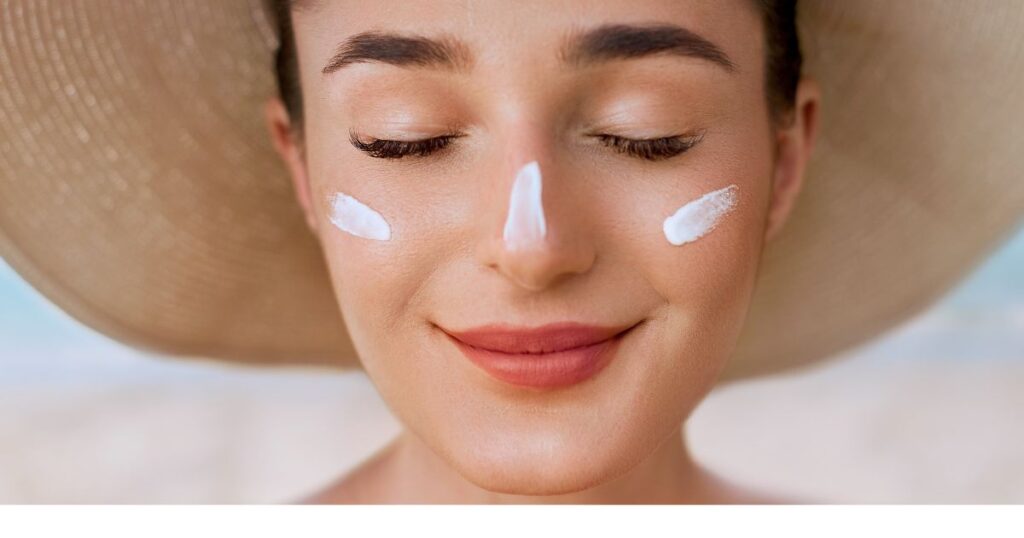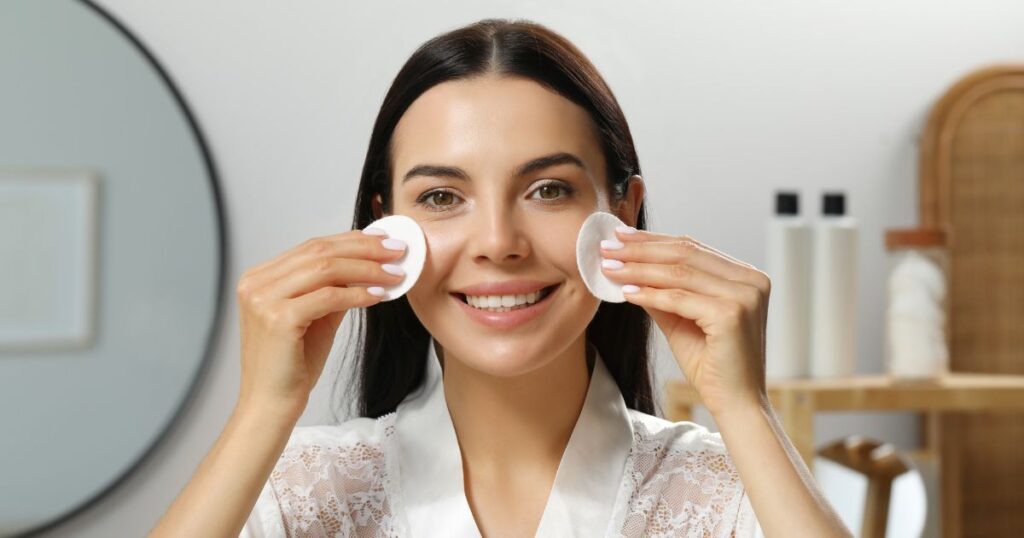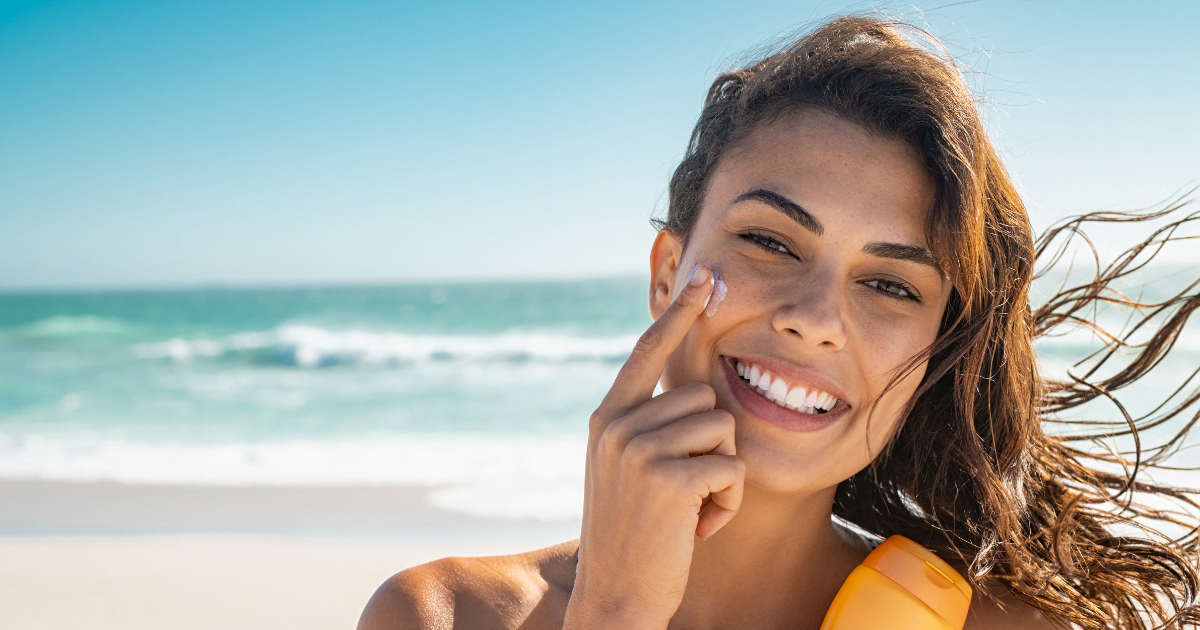One product at the forefront of the clean beauty movement is mineral sunscreen, a product gaining acclaim not just for its efficacy but for its alignment with our evolving values of health and eco-consciousness.
We’ll explore the essence of mineral sunscreen, including its foundational ingredients and the mechanism by which it shields our skin from the sun’s rays. We’ll go beyond the basics, sharing the compelling advantages of mineral over chemical sunscreens, the nuances of application, and effective removal techniques.
Expect to uncover:
- The defining traits of mineral sunscreen and its clean beauty credentials.
- Comparative insights highlighting why mineral sunscreen outshines its chemical counterparts.
- Practical guidance on applying and removing mineral sunscreen, tailored to enhance your clean beauty regimen.
Table of Contents - Click to Go
What is Mineral Sunscreen?
Mineral sunscreen uses minerals as its main active ingredient to protect your skin from the sun. These minerals, usually zinc oxide or titanium dioxide, sit on top of your skin and work by reflecting away UV rays, like tiny mirrors.
Unlike chemical sunscreens that absorb into the skin and then absorb UV rays, mineral sunscreens provide a barrier that blocks the sun’s rays from penetrating the skin at all. This makes them a favorite for sensitive skin types since they’re less likely to cause irritation.
They start working the moment you apply them—no waiting required. Plus, they’re considered reef-safe, meaning they’re less harmful to marine ecosystems than some chemical sunscreens.
How Mineral Sunscreens Work
- Physical Barrier: Mineral sunscreens create a physical barrier on the surface of the skin. Instead of absorbing into your skin, they sit atop it.
- Reflect UV Rays: This barrier reflects UV rays away from the skin, acting much like a mirror. Because of this, they are also known as physical sunscreens.
Key Ingredients
- Zinc Oxide: Known for its ability to protect against a broad spectrum of UV rays, zinc oxide is gentle enough for all skin types, including sensitive skin and combination skin.
- Titanium Dioxide: Another gentle ingredient that works in tandem with zinc oxide to provide comprehensive sun protection.
Mineral vs. Chemical Sunscreens
- Immediate Protection: Unlike chemical sunscreens, which need time to become effective, mineral sunscreens protect your skin from the moment they are applied.
- Fewer Irritants: The natural composition of mineral sunscreens means they are less likely to cause skin irritation, making them ideal for those with sensitive skin or conditions like eczema.
- Eco-Friendly: Mineral ingredients are safer for marine ecosystems, including coral reefs, which are adversely affected by some chemical UV filters.
Why is Mineral Sunscreen Better Than Chemical Sunscreens?

When it comes to protecting your skin from the sun, not all sunscreens are created equal. Mineral sunscreen has emerged as a superior choice for several compelling reasons, spanning safety, environmental impact, health benefits, and efficacy.
Safety
- Less Absorption: Mineral sunscreens sit on the skin’s surface, significantly reducing the risk of absorption into the body. This feature makes them a safer choice, especially for vulnerable groups like children and pregnant women.
- Natural Ingredients: With zinc oxide and titanium dioxide as main components, mineral sunscreens leverage natural minerals, minimizing exposure to synthetic chemicals.
Environmental Impact
- Reef-Safe: The ingredients in mineral sunscreens are less harmful to coral reefs and aquatic life, addressing the growing concerns over sunscreen-induced coral bleaching.
- Biodegradable: Many mineral sunscreen formulas are biodegradable, contributing to a smaller ecological footprint.
Health Benefits
- Sensitive Skin Friendly: The gentle nature of the ingredients in mineral based sunscreens make them suitable for people with sensitive skin or skin conditions like rosacea and acne.
- No Chemical Irritants: By avoiding chemical UV filters, mineral sunscreens reduce the risk of skin irritation and allergic reactions.
Efficacy
- Broad Spectrum SPF Protection: Mineral sunscreens provide broad-spectrum coverage, effectively protecting against both UVA (aging) and UVB (burning) rays.
- Immediate Effectiveness: They start protecting your skin immediately upon application—no wait time required.
Recent studies and expert opinions consistently highlight the advantages of mineral sunscreens. Dermatologists often recommend them for their effective protection and lower risk of skin irritation, underlining their suitability for all skin types, including the most sensitive.
How to Apply Mineral Sunscreen Effectively

Achieving maximum protection with mineral sunscreen isn’t just about choosing the right product; it’s also about applying it correctly. It’s unique physical properties require a slightly different approach than their chemical counterparts. Here’s your guide to ensuring you’re getting the most out of your mineral sunscreen for all-day, effective sun protection.
- Quantity Matters: For full body coverage, most dermatologists recommend using approximately one ounce (the size of a shot glass) of SPF 50 or higher sunscreen. For the face alone, a nickel-sized dollop should suffice.
- Even Coverage: Apply the sunscreen to all exposed skin, remembering easily overlooked areas like the ears, back of the neck, and tops of the feet. For those with thinning hair, don’t forget the scalp or wear a hat.
- Rub it in Well: Mineral sunscreen may require a bit more effort to rub in completely. Take the time to ensure it’s evenly distributed, minimizing white streaks or patches.
- Under Makeup: If you’re wearing makeup, apply mineral sunscreen as a base. Allow it to fully absorb and dry before applying makeup over it.
- Reapply Regularly: Sunscreen should be reapplied every two hours, or more frequently if swimming or sweating heavily. This is crucial for maintaining effective protection throughout the day.
Making Thicker Formulas Easier to Apply
- Warm it Up: Warm the sunscreen by rubbing it between your hands before applying. This can help make the formula more pliable and easier to spread.
- Moisturize First: Applying a light moisturizer before your sunscreen can help it glide on more smoothly, especially if you have dry skin.
Incorporating Mineral Sunscreen into Your Clean Beauty Routine
- Daily Habit: Make sunscreen application a non-negotiable part of your morning routine, regardless of the weather. UV rays can penetrate clouds and even windows.
- Layer Smartly: For those using additional skin care products, apply your sunscreen last in your skincare routine but before makeup.
By following these steps, you can maximize the protective benefits of your mineral sunscreen, ensuring your skin remains shielded against harmful UV rays while supporting your clean beauty values. Remember, effective sun protection is a cornerstone of healthy skin care and plays a critical role in preventing sun damage and skin cancer.
How to Remove Mineral Sunscreen

After a day of protecting your skin from the sun’s harmful rays, removing mineral sunscreen is a crucial step in your skincare routine. Due to its physical blocking properties, it can be more challenging to remove than chemical formulas. However, with the right approach, you can cleanse your skin effectively without stripping it of moisture.
Why It’s Harder to Remove:
- Physical Barrier: Mineral sunscreens form a protective layer on the skin’s surface, which can be resistant to regular face wash.
- Water-Resistant Formulas: Many mineral sunscreens are designed to be water-resistant, making them stick to the skin more stubbornly.
Gentle and Effective Removal Methods
- Oil Cleansing: Start with an oil-based cleanser or a dedicated cleansing oil. Apply it to dry skin and gently massage in circular motions. Oils are effective at dissolving sunscreen without harsh rubbing. Good examples include jojoba oil, sweet almond oil, or commercial cleansing oils.
- Double Cleansing: After oil cleansing, follow up with a gentle water-based cleanser to remove any residual oil and sunscreen. This two-step process ensures your skin is thoroughly clean.
- Micellar Water: For sensitive skin, micellar water can be a gentle alternative. Soak a cotton pad and gently wipe over the face until the sunscreen is removed.
- Warm Water and Soft Cloth: Using warm water and a soft, clean cloth can help loosen and lift the sunscreen. Be gentle to avoid irritating the skin.
Tips for Sensitive Skin:
- Avoid harsh scrubbing or exfoliating tools, which can irritate the skin further.
- Look for clean beauty options in cleansers that are free from sulfates and alcohol.
By incorporating these methods into your mineral sunscreen experience, you can ensure that your skin is clean and ready to breathe and regenerate overnight.
How to Get Mineral Sunscreen Out of Clothes
While mineral sunscreen is a champion for skin health and environmental sustainability, it can sometimes leave stubborn stains on clothes. These stains are typically due to the oils and minerals (zinc oxide and titanium dioxide) in the sunscreen. However, with environmentally friendly methods and a bit of know-how, you can effectively remove these stains, keeping both your skin and your wardrobe in pristine condition.
Immediate Action is Key. As soon as you notice a stain, pre-treat it with a gentle, eco-friendly stain remover before washing. This step helps to break down the oils and minerals, making it easier to wash out.
Natural Solutions for Removing Sunscreen Stains
- Baking Soda Paste:
- Mix baking soda with water to create a paste.
- Apply directly to the stain and let it sit for at least 30 minutes.
- Gently scrub with a soft brush or cloth before washing as usual.
- White Vinegar Solution:
- Combine equal parts water and white vinegar.
- Soak the stained area for 30-60 minutes.
- Rinse and then launder as normal.
- Lemon Juice for Light Fabrics:
- Apply lemon juice to the stain and expose it to sunlight for a few hours.
- The natural bleaching effect of lemon juice and sunlight can help fade the stain.
- Wash the garment as usual afterward.
Washing Tips
- Cool Water: Wash the garment in cool water. Hot water can set the stain further into the fabric.
- Gentle Detergent: Use a gentle, eco-friendly detergent to avoid damaging the fabric or adding more chemicals to your clothing.
- Air Dry: Whenever possible, air dry the garment instead of using a dryer, as high heat can make stains more difficult to remove.
Preventive Measures
- Apply Carefully: Try to apply mineral sunscreen away from clothing or wear a towel to protect your garments.
- Wash Hands: After applying sunscreen, wash your hands to avoid transferring residue to clothes.
Use Mineral Sunscreen For Broad Spectrum Protection

Mineral sunscreen stands at the intersection of skin health, environmental responsibility, and informed consumerism, embodying the principles of the clean beauty movement. Through our journey, we’ve uncovered the essence of mineral sunscreen, its unparalleled benefits over chemical alternatives, and practical tips for seamless application and removal.
FAQ
What makes mineral sunscreen a clean beauty product?
- Natural Ingredients: Primarily uses zinc oxide and titanium dioxide, which are natural minerals.
- Eco-Friendly: Less harmful to marine life and ecosystems compared to chemical sunscreens.
- Skin-Safe: Generally safer for sensitive skin due to fewer chemical irritants.
How often should I reapply mineral sunscreen?
- Every 2 Hours: Especially if swimming or sweating.
- After Toweling Off: Reapply immediately as physical removal decreases effectiveness.
Can mineral sunscreen be used on all skin types?
- Yes: Particularly beneficial for sensitive, acne-prone, or rosacea-affected skin due to its gentle nature.
Is mineral sunscreen water-resistant?
- Varies by Product: Look for labels stating water-resistance and note the duration (e.g., 40 or 80 minutes) for optimal protection.
How can I ensure my mineral sunscreen doesn’t leave a white cast?
- Rub Well: Ensure thorough application by rubbing into the skin well.
- Tinted Formulas: Opt for tinted versions designed to blend seamlessly with your skin tone.
Does mineral sunscreen have an expiration date?
- Yes: Typically lasts for up to 3 years. Check packaging for specific expiration dates and replace as needed to maintain effectiveness.
Can I use mineral sunscreen on my face and body?
- Yes: There are formulas specifically designed for facial use, offering additional skincare benefits while providing sun protection.
How does mineral sunscreen impact marine life compared to chemical sunscreens?
- Less Harmful: Ingredients in mineral sunscreens are considered safer for aquatic ecosystems, contributing to the preservation of coral reefs and marine species.
Are there tinted mineral sunscreens available?
- Yes: Tinted options are available to suit different skin tones, offering a more natural look without the white residue.
Is it necessary to use mineral sunscreen on cloudy days?
- Absolutely: UV rays penetrate clouds, making sunscreen essential year-round, regardless of weather conditions.

